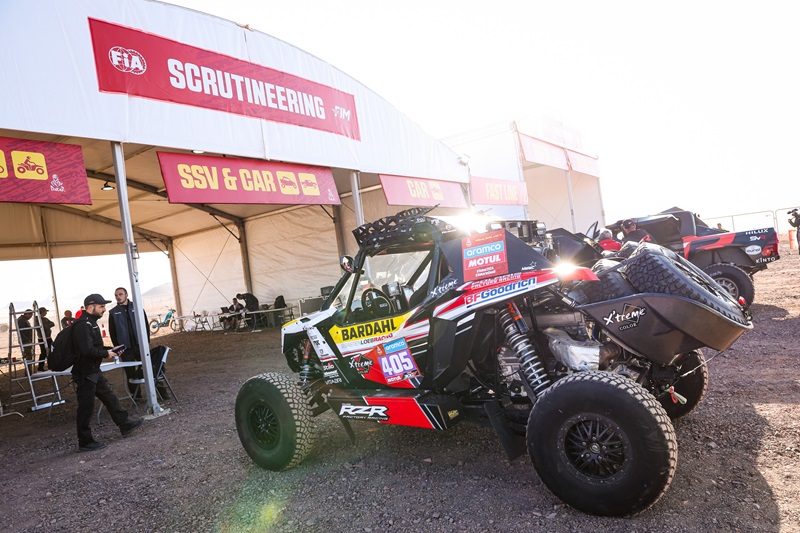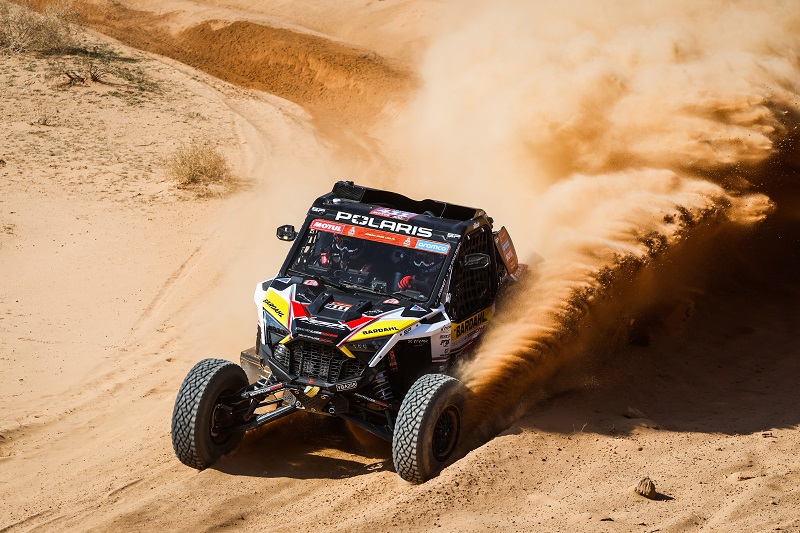The Polaris RZR Pro R Factory tore it up in SCORE International during Polaris Factory Racing‘s début season in 2023, and is currently doing the same at the 2024 Dakar Rally with Sébastien Loeb Racing. After six of twelve legs, Xavier de Soultrait has three stage wins in the RZR and ranks third overall in the SSV class.
The SSV category, formerly T4, is often dominated by Can-Am who won the 2022 and 2023 World Rally-Raid Championships. Mavericks also hold a massive number advantage with twenty-eight entered to just eight Polarises, two of which are the Pro R Factory fielded by SLR while the others are fielded by Xtremeplus and TH-Trucks Team. Despite being outnumbered, Polaris Factory Racing technical director Alex Scheuerell called himself “very confident” in SLR’s duo, and his belief in them has paid off tremendously at the halfway point. De Soultrait’s stage victories are the first at Dakar for a Polaris since Patrice Garrouste won the penultimate leg in 2018.
Scheuerell explained to The Checkered Flag that his faith in SLR and the RZR Pro R Factory comes from the “proof (that) is in the 2023 Baja results.” Despite the factory team being new, they won the Pro UTV Open class at all four SCORE races with team principal Craig Scanlon claiming the San Felipe 250, Brock Heger winning the Baja 500 and Baja 400, and Cayden MacCachren conquering the Baja 1000. Heger, a short course off-road racing champion, secured the season-long SCORE title in the category.
“We expect some growing pains this year in Dakar, but we are excited to learn and are hopeful that our engineering, the drivers and crew at Sébastien Loeb, and our preparation will be the difference,” said Scheuerell.
Although there are similarities such as the base chassis and powertrain being the same, the RZR Pro R Factory that de Soultrait and Florent Vayssade are racing is slightly different from the model that competes in SCORE and other desert races in North America under the Polaris Factory banner. After all, rally raids like the Dakar have different demands for vehicles than in traditional desert events; for example, there is integrated storage space in the rally version for spare parts and tools, which comes in handy at marathon stages where crews are not allowed to provide assistance. Other changes, particularly to the chassis, were made to comply with FIA regulations.
The Pro R Factory is powered by a two-litre Polaris ProStar Fury 2.0 engine housed inside a tubular chassis that was designed to be lighter yet stronger than that of its predecessor RZR Pro R. Both the Dakar and American cars use the same motor as well as FOX 3.0 Live Valve X2 internal bypass shocks.
“Internally, we call the two variants the North America (NA) and the other international or FIA models,” Scheuerell told TCF. “The FIA does not allow anti-intrusion bars in the windscreen area, and we weld on additional brackets for things like windshield wipers, different bodywork, and different close-off panels in the cockpit. The most noticeable differences are that the FIA version has a windscreen, complete with wipers, washers, and defrosters. The addition of the windshield coupled with more extensive close-off panels, requires the need to add roof scoops for the engine radiator intake and clutch cooling intake.
“We also have additional carbon-fibre side pods on the FIA variant that are needed for the spare parts and tools required for long remote stretches in the Saudi desert where you aren’t able to have as much contact with your support crew as in North American races. Finally, we also have a carbon fibre spare tyre carrier on the FIA version designed to carry two spare tyres while reducing pitch and yaw inertia as much as possible. For the NA variant, we only carry one spare tyre but position it to increase pitch inertia to help the vehicle track straight and flat through the aggressive terrain found in Baja.”
While the Pro R Factory first raced in SCORE before Dakar, Scheuerell noted the “initial car was designed with the FIA rules in mind.” The FIA’s cross-country rally department has some overlap with SCORE, most notably in the top-level Ultimate (formerly T1) class where SCORE-compliant vehicles race in the T1.3 subcategory, though the sanctioning body obviously has its own policies that the team had to meet. This was also tricky as the SSV class is designed for mostly production side-by-side vehicles, unlike the purpose-built racing side-by-sides in Challenger.
“This proved very difficult to do once you really peel back the onion and figure out all of small, detailed nuances between the different series,” he commented. “In some cases, it’s good; for example, the FIA is very stringent on safety cage structure design, FEA analysis, and certification, which leads to spend a lot of time in FEA optimising load paths. The North American variant uses the exact-same safety cage structure (with the addition of the anti-intrusion bar) which benefits from those stringent FIA rules. With that being said, there are some other odd rules in the FIA that made us scratch our head, like the requirement that no engine part is allowed to be visible from directly overhead for aesthetic reasons.
“We had to design some funky shields to satisfy this rule, which are not aesthetic! Another big one for us is that the T4 SSV class requires the use of production body work, which drove a lot of changes and bracketry to make work because the NA variant uses a lot of carbon fiber bodywork.”

The rally raid variants are labelled as “second generation”, building upon the first-generation models that raced Baja last year. Its development was conducted by Polaris Engineering and Scanlon Clarke Incorporated, the latter co-owned by PFR heads Scanlon and Travis Clarke.
“We took all of the lessons learned in the first year of racing our GEN1 factory RZRs in Baja and applied them to our GEN2 design,” he stated. “The SLR Dakar RZRs are our first GEN2 cars out of our workshop, which have a lot of small durability, electronics, ergonomics improvements, etc.
“We have two ‘groups’ on the Polaris Factory Racing Team: Polaris Engineering, mostly in Minnesota, who design and build the race cars and SCi out of California, who prep and race our factory RZRs. The Engineering group has spent the past year on the Dakar programme with help and advice from our SCi arm.”
After six stages, de Soultrait ranks third overall in SSV, trailing leader Yasir Seaidan by 5:30 with wins at the Prologue, Stage #5, and the two-day Chrono Stage. Vayssade is eighth after having to overcome early incidents like a damaged rear bumper in the first stage and a damaged steering arm two days later that caused him to fall behind by three hours.
Both drivers are French and hail from bike racing backgrounds. De Soultrait was the 2016 FIM Bajas World Cup champion who raced the Dakar on two wheels from 2014 to 2022 before switching to an SSV in 2023. Vayssade, an enduro rider, did four Dakars on a bike and also made the jump to four wheels last year.
“We have a belief that (generally speaking) that if you are fast on a dirt bike, you will be fast in a SxS,” remarked Scheuerell. “We love working with former bike racers because they are fast, smooth, and easy on equipment. Xavier and Florent are no exception and I was able to confirm during our two test sessions here in the U.S. so (we) are confident in their abilities.”
De Soultrait finished nineteenth in his Dakar T4 début, while Vaysssade placed tenth in a Can-Am before joining SLR. The team’s namesake owner has two stage wins in 2024, including the Chrono Stage, and sits third in the Ultimate overall. SLR forged a five-year factory partnership with Polaris starting 2023.
“I was a big fan of Sébastien during his WRC days and then was fortunate to meet with him this last summer in Geneva,” Scheuerell recalled. “I can’t say enough good things about him. He is as humble and interesting of a person as he is fast in a race car. He has great vision for his race team and has a lot of confidence in us.”



